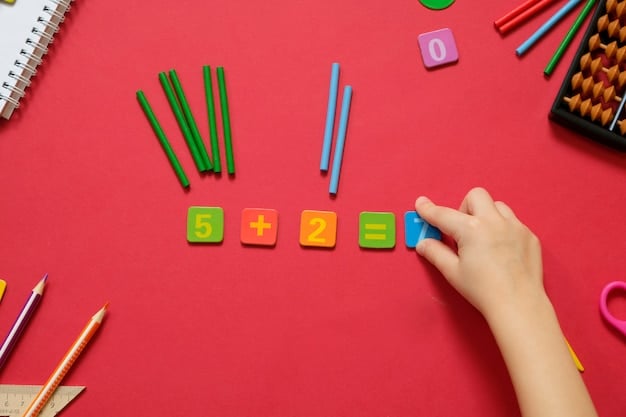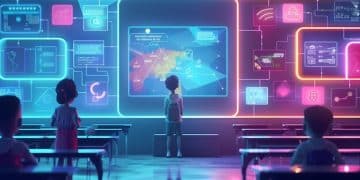Learning Disabilities: Types, Identification & Support in 2025

Understanding the Different Types of Learning Disabilities: Identification and Support Strategies in 2025 involves recognizing various neurological conditions that affect cognitive processes, impacting academic and daily life skills, and necessitates tailored educational approaches and support systems to foster individual potential.
Navigating the world of learning disabilities can be challenging, but understanding the different types of learning disabilities: identification and support strategies in 2025 is crucial for educators, parents, and individuals alike to foster a supportive and inclusive learning environment.
Understanding Learning Disabilities: An Overview
Learning disabilities are neurological conditions that affect a person’s ability to learn, process information, and acquire skills in specific areas. These disabilities are not indicative of intelligence but rather reflect differences in how the brain processes information.
In 2025, understanding these differences is more critical than ever, as educational approaches become increasingly personalized and technology-driven. Let’s explore the various types of learning disabilities and the strategies for identifying and supporting individuals with these challenges.
What Are Learning Disabilities?
Learning disabilities are characterized by difficulties in one or more cognitive processes, such as reading, writing, mathematics, or attention. These difficulties can manifest in various ways and can impact academic performance, self-esteem, and social interactions. It’s essential to recognize that learning disabilities are not a result of lack of effort, motivation, or intelligence.
Prevalence of Learning Disabilities
Learning disabilities are more common than many people realize. According to the National Center for Learning Disabilities, approximately 1 in 5 children in the United States have a learning disability. This statistic underscores the importance of early identification and intervention to help individuals reach their full potential.
- Early identification can lead to more effective interventions.
- Supportive educational environments can improve academic outcomes.
- Understanding learning disabilities reduces stigma and promotes inclusion.
Understanding the definition and prevalence of learning disabilities is the first step toward creating a more inclusive and supportive educational landscape. Early identification and tailored support are key to helping individuals overcome these challenges and thrive.
Dyslexia: Decoding the Challenges of Reading
Dyslexia is perhaps the most well-known type of learning disability, primarily affecting reading and language-based processing skills. It’s not merely about reversing letters; it’s a complex neurological condition that impacts phonological awareness, decoding, and reading fluency.
In 2025, advanced research and tailored interventions are providing new hope and strategies for individuals with dyslexia to overcome these challenges. Let’s delve into the specifics of dyslexia and how it affects reading skills.

Key Characteristics of Dyslexia
Dyslexia is characterized by difficulties with accurate and fluent word recognition, poor spelling, and decoding abilities. These challenges typically result from a deficit in the phonological component of language that is often unexpected in relation to other cognitive abilities and effective classroom instruction.
Strategies to Support Individuals with Dyslexia
Effective strategies for supporting those with dyslexia include multisensory teaching methods, phonics-based instruction, and assistive technology. Multisensory approaches engage multiple senses (sight, sound, touch, movement) to enhance learning and memory. Assistive technology, such as text-to-speech software, can also be invaluable in supporting reading comprehension.
- Multisensory teaching integrates sight, sound, and touch.
- Phonics-based instruction focuses on the relationship between sounds and letters.
- Assistive technology provides tools to support reading and writing.
Dyslexia presents unique challenges to reading and language processing, but with early identification and targeted interventions, individuals with dyslexia can develop effective strategies to overcome these difficulties and achieve academic success. Understanding the specific needs of each individual is crucial in tailoring the most effective support.
Dysgraphia: Unraveling Writing Difficulties
Dysgraphia is a learning disability that affects writing abilities, including handwriting, spelling, and the organization of thoughts on paper. It’s more than just messy handwriting; it involves challenges with the motor skills required for writing and the cognitive processes involved in composing text.
As we advance into 2025, let’s examine the nuances of dysgraphia and explore the strategies and technologies that can support individuals in developing their writing skills despite these challenges.
Understanding the Symptoms of Dysgraphia
Symptoms of dysgraphia can vary, but often include difficulties with letter formation, spacing, spelling, grammar, and organizing thoughts in a coherent manner. Children with dysgraphia may struggle to write legibly, even with effort, and may find writing a slow and laborious task.
Effective Support Strategies for Dysgraphia
Occupational therapy can help improve the motor skills required for handwriting, while assistive technology, such as speech-to-text software, can alleviate the burden of physical writing. Additionally, providing structured writing prompts and graphic organizers can help individuals organize their thoughts and improve the coherence of their writing.
- Occupational therapy can enhance fine motor skills.
- Speech-to-text software reduces the physical demand of writing.
- Writing prompts and graphic organizers aid in structuring thoughts.
Dysgraphia impacts various facets of writing, from the physical act of handwriting to the cognitive processes of organizing thoughts. By employing a combination of occupational therapy, assistive technology, and structured writing strategies, individuals with dysgraphia can overcome these challenges and effectively communicate their ideas.
Dyscalculia: Addressing Mathematical Challenges
Dyscalculia is a learning disability that affects a person’s ability to understand and work with numbers and mathematical concepts. It’s not just a matter of disliking math; it’s a neurological condition that impacts number sense, math facts, and calculation skills.
In 2025, educators and researchers are developing innovative approaches to support individuals with dyscalculia, leveraging technology and tailored instructional methods. Let’s explore the challenges of dyscalculia and the strategies that can help individuals succeed in math.

Identifying the Signs of Dyscalculia
Signs of dyscalculia include difficulty understanding number concepts, struggling with math facts, confusion with mathematical symbols, and challenges with mental math. These difficulties can impact academic performance and daily life skills, such as managing money or telling time.
Strategies for Supporting Individuals with Dyscalculia
Effective strategies for supporting individuals with dyscalculia include using visual aids, hands-on manipulatives, and breaking down complex math concepts into smaller, more manageable steps. Technology, such as educational apps and software, can also provide personalized instruction and practice opportunities.
- Visual aids can help make abstract concepts concrete.
- Hands-on manipulatives allow for tactile learning experiences.
- Personalized technology provides targeted practice and support.
Dyscalculia presents significant challenges to understanding and working with numbers, but with the right support and interventions, individuals with dyscalculia can improve their math skills and gain confidence in their abilities. Tailored instruction and the use of visual and tactile aids are key to their success.
Auditory Processing Disorder (APD): Understanding Listening Difficulties
Auditory Processing Disorder, or APD, is a condition that affects the way the brain processes auditory information. Individuals with APD have difficulty understanding speech, even when their hearing is normal. This can lead to challenges in learning, communication, and social interactions.
As we move into 2025, understanding and addressing APD becomes increasingly crucial. Let’s explore the specifics of APD and how it impacts listening and learning skills.
Symptoms and Impact of APD
Symptoms of APD include difficulty understanding speech in noisy environments, trouble following directions, and challenges with auditory memory. These difficulties can significantly impact academic performance, making it hard to follow lessons and complete assignments effectively.
Support Strategies for APD
Creating a quiet and structured learning environment is essential for individuals with APD. Using visual aids, providing written instructions, and repeating information can also help. Assistive listening devices, such as FM systems, can improve the clarity of speech and reduce background noise.
By providing a supportive and structured learning environment, individuals with APD can overcome many of the challenges associated with this condition and succeed academically. Clear communication and the use of visual and auditory aids can significantly improve their learning experience.
Non-Verbal Learning Disabilities (NVLD): Recognizing Visual-Spatial Challenges
Non-Verbal Learning Disabilities (NVLD) are characterized by difficulties with visual-spatial skills, motor coordination, and social interaction. Unlike dyslexia, which primarily affects language-based skills, NVLD impacts the ability to understand non-verbal cues, spatial relationships, and problem-solving.
In 2025, it is increasingly important to understand NVLD and its effects on learning and social development. Let’s explore the characteristics of NVLD and strategies to support those who have it.
Individuals with NVLD often excel in verbal areas but struggle with visual-spatial tasks, such as reading maps, understanding diagrams, and coordinating movements. They may also have difficulty interpreting non-verbal cues, such as facial expressions and body language, which can lead to social challenges.
Strategies for supporting individuals with NVLD include providing explicit instruction in visual-spatial skills, breaking down complex tasks into smaller steps, and using visual aids to enhance understanding. Social skills training can also help individuals learn to interpret non-verbal cues and improve their social interactions.
- Explicit instruction can improve visual-spatial abilities.
- Task breakdown simplifies complex assignments.
- Social skills training enhances social competence.
While NVLD poses distinct challenges, early identification and tailored support can help individuals develop their strengths and overcome their weaknesses. By addressing their visual-spatial and social challenges, we can empower them to succeed academically and socially.
| Key Point | Brief Description |
|---|---|
| 📚 Dyslexia | Difficulty with reading and language processing. |
| ✍️ Dysgraphia | Affects writing abilities, including handwriting and spelling. |
| ➕ Dyscalculia | Challenges with understanding numbers and math concepts. |
| 👂 APD | Difficulty processing auditory information and understanding speech. |
Frequently Asked Questions
▼
Common signs include difficulty reading, writing, or doing math, struggling to follow directions, and having trouble with memory. These signs can vary based on the specific learning disability.
▼
Early identification involves screening and assessment by educational professionals. Parents and teachers should be vigilant about academic struggles and seek professional help if concerns arise.
▼
Effective support strategies include individualized education plans (IEPs), specialized tutoring, assistive technology, and creating a supportive learning environment at home and school.
▼
Yes, with the right support and interventions, individuals with learning disabilities can achieve academic success. Tailored strategies and a positive attitude are crucial for their development.
▼
Parents can advocate by staying informed about their child’s rights, working closely with educators, and seeking appropriate resources and support. Open communication is essential for advocating effectively.
Conclusion
Understanding the different types of learning disabilities and implementing effective identification and support strategies is crucial for fostering an inclusive and supportive educational environment in 2025. By recognizing the unique challenges faced by individuals with learning disabilities and providing tailored interventions, educators and parents can empower them to reach their full potential and succeed academically and in life.





